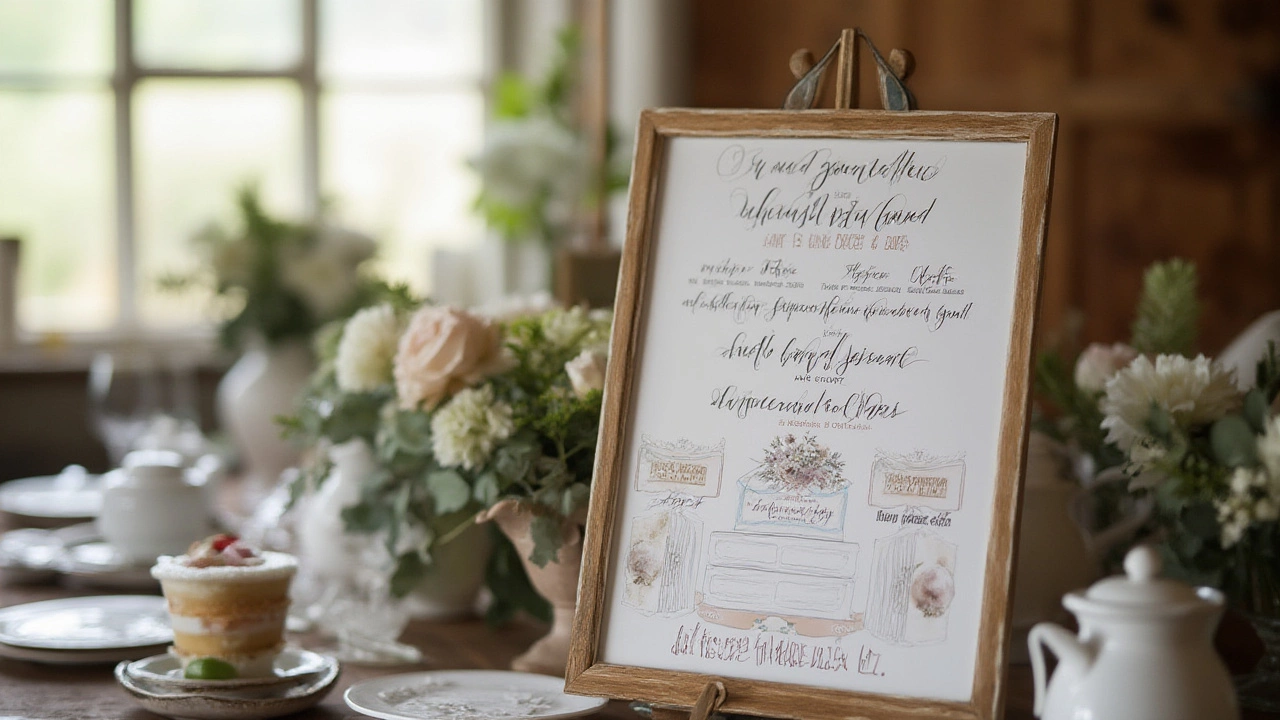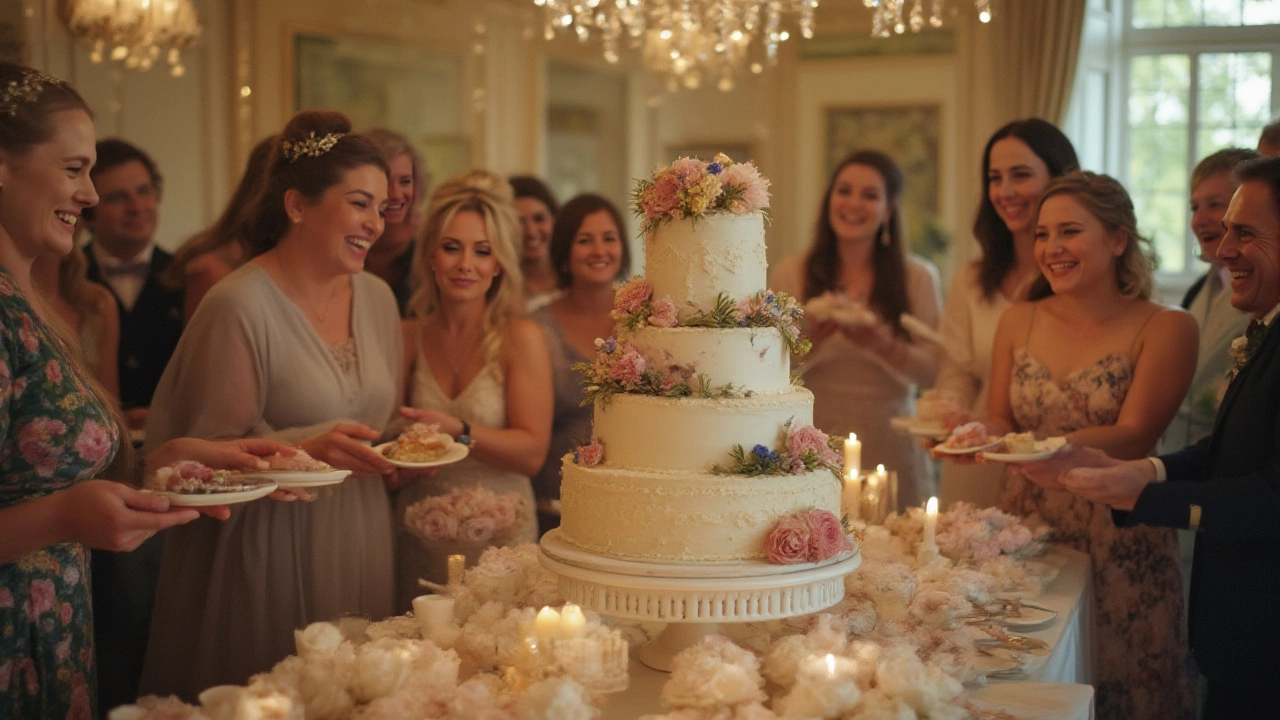Imagine: you’re at a wedding, music’s great, everyone’s in a good mood—and suddenly the cake comes out. You start hoping you won’t end up with a sliver the size of a postage stamp, or worse, that empty plate of disappointment. But how do couples avoid the classic not-enough-cake disaster? The secret actually starts months before, in a cake tasting session, spreadsheet in hand—and more than a little confusion about exactly how big the cake should be. Deciding what size cake will feed 150 guests isn’t just about ordering a massive dessert. People always underestimate just how much goes into getting it just right. Let’s break it down, bit by bit, so each guest gets a perfect slice, and you’re not left with stacks of leftover cake (even though, let’s be honest, nobody complains about extra cake).
How Many Servings in a Cake? Breaking Down the Numbers
When it comes to weddings, guests expect something truly wow-worthy, and a towering cake delivers on that. But before you settle on three tiers or five, it’s smart to know how many servings those tiers provide. Most bakeries, including top cake artists in Dublin, measure slices by the standard wedding portion — a 1-inch by 2-inch slice. That size is smaller than what you’d cut for a birthday party, but for weddings, it’s the gold standard. A lot of people don’t realize how much cake those wedding slices actually add up to.
Here’s a handy table for quick reference. Typical round wedding cakes go by these numbers, so you can start to picture just how much cake you’ll need:
| Cake Tier Size (Diameter) | Servings (Wedding Cuts) |
|---|---|
| 6" | 12 |
| 8" | 24 |
| 10" | 38 |
| 12" | 56 |
| 14" | 78 |
So, say a classic three-tier cake uses 6”, 9”, and 12” rounds. That’s roughly 12 (6”) + 32 (9”) + 56 (12”) = 100 servings. Not enough for 150 guests! You need more. That’s where four or even five tiers come in. Or there’s an alternative: have a modest display cake with extra “kitchen cakes” hidden in the back. These are simpler, sheet cakes you don’t display but serve, so everyone gets a proper slice without breaking the bank or building a skyscraper of a cake.
As one expert, Peggy Porschen, famous London cake designer, says,
"When planning a cake for a big crowd, always allow for at least 10% extra. There’s always someone who wants seconds, or friends who turn up unexpectedly."Turns out, making just enough usually means making a bit more, just in case.
What Size Cake Do You Really Need for 150 Guests?
Let’s get specific. For 150 guests, you want to plan for at least 150 portions, but giving yourself a buffer is wise. Maybe 160-170 portions, especially since you’ll want slices for the couple and maybe the odd vendor or two. Most local wedding cake makers recommend going for a cake that has four to five tiers, especially if you’re keen on a traditional look. But remember, it’s the diameter of the tiers that really counts—not just how tall the cake is.
Here’s how a 4-tier cake often looks for a wedding crowd of this size (using round cakes):
- 6-inch top tier: 12 servings
- 8-inch second tier: 24 servings
- 10-inch third tier: 38 servings
- 14-inch base tier: 78 servings
That adds up to 152 servings. Pretty much spot-on! You could swap the 14” for a 12”, but then you’d dip below 150, which can get risky if you’ve got hungry guests or want to save a few slices for yourselves. Add one extra kitchen cake (often in a matching flavour, or something simple but crowd-pleasing like Victoria sponge or chocolate) of about 8” x 12” and you’ve got 24 more servings up your sleeve. Kitchen cakes can quietly save the day, and nobody even knows they were ever in the back—the presentation cake gets cut for the photos, then out comes the neatly sliced backup in the kitchen.
If you’re hoping for a taller, dramatic centrepiece, talk to your baker about using foam “dummy” tiers. These tiers look real, give you the height, but aren’t edible—so you don’t waste cake (and money) on décor. You just focus on the *real* cake, keeping portion sizes right.
Don’t forget about shape, too. Square cakes serve more per tier than round ones, so you could go for a three-tier square cake and hit your target. Here’s a quick comparison:
- 10” square: 50 servings
- 12” square: 72 servings
- 14” square: 98 servings
Stack two of those, you’re already at 122 slices—add a third tier, and you’re golden (and probably have cake to spare). But round cakes remain the most popular choice for weddings, mostly because they cut so elegantly and look fairy-tale beautiful in photos.

Tips for Customising Cake Size Without Compromising Style
Sometimes, you want that wow-factor cake, but your guest list or budget puts a squeeze on things. There are smart ways to get the best of both worlds without looking like you cheaped out or overdid it. Here are some tips from local bakers and planners I’ve picked up, working in Ireland and seeing hundreds of wedding cakes each season:
- Stacking for drama: If you want a tall, impressive cake but don’t need all the servings, opt for false (foam) tiers in the bottom or middle. Bakers decorate them exactly like the real thing, and nobody ever notices.
- Kitchen cakes to the rescue: As mentioned before, simply order kitchen cakes to increase servings. They cost less (since they skip the fancy outer decoration) and let you keep costs down but still feed the crowd.
- Mixing shapes: Try combining a round base with smaller square tiers above—visually interesting, and lets you tweak servings per tier.
- Flavours for every crowd: Big weddings mean varied tastes. Go for two or three popular flavours across different tiers, so everyone gets a choice.
- Tier height matters: Standard tiers are about 4 inches tall, but some bakers offer taller, more dramatic layers. Remember, taller doesn’t always mean more servings if the diameter stays the same.
- Allergies and dietary needs: Gluten-free, nut-free, or vegan tiers are becoming more popular—always ask your guests in advance and let your baker know early in the process.
- Don’t forget leftovers: Couples often want to save their top tier for anniversaries. Plan for that when calculating your servings, so you’re not short on the night.
Colour and decoration don’t affect servings but absolutely ramp up the impact. Go for fresh flowers, seasonal fruit, metallic paints, or personalised toppers to fit your wedding style perfectly.
"A wedding cake should taste as good as it looks. The best feedback is always from guests who come back for seconds before anyone realises the cake is gone!" — Tracey O’Shea, award-winning Irish cake designer.
Those little ways to stretch style, serve everyone, and keep within your budget all add up. Don’t be afraid to ask cake makers for creative solutions—they’ve seen it all, from 150-person micro-weddings (yes, that happened post-pandemic) to sprawling country manor affairs where the cake never stopped coming.
Planning, Extras, and Common Cake Size Mistakes
Let’s talk about the classic ways couples misjudge wedding cakes. Some try to save on budget by going for too small a cake, only for family and friends to notice—and nobody wants to hear a chorus of “Is that all there is?” halfway through the party. Others worry so much they end up with tiers left over for days, eating cake with every meal until Tuesday. Getting the numbers right means less anxiety and happier guests.
Mistakes usually happen because people confuse wedding portion sizes with regular cake slices, or forget that bigger cakes need sturdy stands and good serving plans. Here’s what works:
- Talk to your baker about serving sizes. Most professionals use the 1” x 2” slice, but always double-check. Some do heartier slices, especially if the cake is the main dessert.
- Plan for dessert or late-night: If cake is the main sweet treat, portion for every guest. If you have other desserts or a candy buffet, you might scale back a bit—but it’s safer to still plan for almost everyone to take a piece.
- Don’t cut until ready: The longer the cake stays together, the prettier it looks (and it helps the bride and groom get their all-important photos). Coordinate with caterers for the best time to slice and serve.
- Sign the delivery sheet: When your baker delivers, go over the cake tiers and numbers with them. Mistakes are rare but it’s good to double-check and snap a quick photo for peace of mind.
Budget naturally sits centre stage here. In Ireland, a fully decorated, four-tier wedding cake for 150 guests averages €600–€900, depending on flavours, details, and extras. Choosing basic decoration or smaller, hidden kitchen cakes keeps costs in check. Remember, any savings are better invested in a custom cake topper, fresh flowers, or that striking cascade of edible pearls—features people always remember.
And finally: If in doubt? Order a bit extra. Cake freezes beautifully, even if your parents end up sneaking slices home. Staff and vendors often appreciate a little bite, too. It’s one of the rare things at a wedding that everyone likes. With a little planning (and maybe an extra spatula or two), every guest will leave with sweet memories and a satisfied smile.
